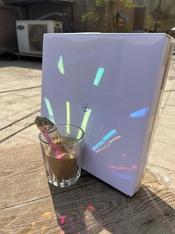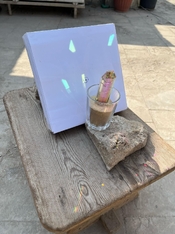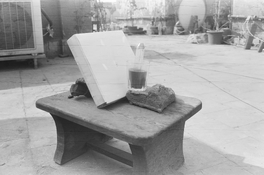O z
Member
Noted. Thank you!This is more due to the base material than to the sensitivity of the emulsion. There are a number of panchromatic and even super-panchromatic (extended red sensitivity) films with the same concern.
Noted. Thank you!This is more due to the base material than to the sensitivity of the emulsion. There are a number of panchromatic and even super-panchromatic (extended red sensitivity) films with the same concern.
It'll be more useful to shoot a color checker like @Donald Qualls suggested. Green subjects are a little tricky because it depends on how the green is built up. Green can be something that reflects light in a fairly narrow 520-550nm wavelength band, or it can be a composite of colors that reflects a broad range of wavelengths ranging from UV up to 550nm or so. The implication is that some typically green subjects, such as green plants/leaves, actually reflect a decent amount of blue light and thus will appear relatively light-colored on a blue-sensitive recording. This isn't because the blue-sensitive medium is also sensitive to green, but because there's a decent amount of blue light being reflected by the object. With man-made objects the situation is even more tricky because many man-made pigments have discontinuous spectra.I can shoot a test roll using green subjects and share better results soon.
I missed this comment earlier. Thank you! Will do and report back.Or someone could just shoot a color chart so you can't argue with the results...
It'll be more useful to shoot a color checker like @Donald Qualls suggested. Green subjects are a little tricky because it depends on how the green is built up. Green can be something that reflects light in a fairly narrow 520-550nm wavelength band, or it can be a composite of colors that reflects a broad range of wavelengths ranging from UV up to 550nm or so. The implication is that some typically green subjects, such as green plants/leaves, actually reflect a decent amount of blue light and thus will appear relatively light-colored on a blue-sensitive recording. This isn't because the blue-sensitive medium is also sensitive to green, but because there's a decent amount of blue light being reflected by the object. With man-made objects the situation is even more tricky because many man-made pigments have discontinuous spectra.
If you have a prism, you could create a rainbow effect (use sunlight if possible, and otherwise tungsten; not CFL or LED) and photograph that.
Would printing out a color chart be a viable alternative (for the purpose of this test) to commercially available color charts?
Noted. Thank you!It's tricky. The problem if you digitally print a color chart, it'll most likely be made up of yellow, magenta, cyan and black pigment. What the film will see, depends on the pigments involved. In principle, a pure yellow patch printed with only the yellow ink of an inkjet or laser printer should show up relatively dark on a blue-sensitive film. However, again, it depends on the pigment involved. Moreover, there's a problem with printing this way as it's usually not possible or very difficult to print with a single ink channel only. It generally requires special software tools to do so. Sometimes, there are test pages you can print with a printer (e.g. head alignment charts etc.) that use single channels at a time. You could try and use something along those lines.
So there are several caveats to doing this. Yes, it's possible, but setting up the experiment correctly and the correctly interpreting the results is a little more tricky than it seems at first glance.

I am posting here question about possibilities for increasing ISO of those emulsions in developing process and kindly asking members to share their experiences in order to have it on one place.
Thanks.
Someone out here must have a copy of the second edition of (laser) Bob Shanebrook's fine book "Making Kodak Film". The copy I saw (I don't own one) listed an enormous number of emulsions that Kodak made, and there is likely to some information on the 2612 in question here. Best to go to the source!
Not to side track too much, but doesn't even X-ray film come in blue sensitive and green sensitive? I'm GUESSING a green sensitive form would also be blue sensitive, but I haven't really looked that closely at sensitivity of X-ray film...Only that particular film. Don't assume it's representative for your particular film.
As per my understanding, X-ray film is often used next to a phosphorescent screen. The phosphors could be either green or blue, thus the need for green sensitivity.Since X-rays are below the UV range, it makes no sense for the film to be sensitive to green...
Not to side track too much, but doesn't even X-ray film come in blue sensitive and green sensitive? I'm GUESSING a green sensitive form would also be blue sensitive, but I haven't really looked that closely at sensitivity of X-ray film...
Not to side track too much, but doesn't even X-ray film come in blue sensitive and green sensitive? I'm GUESSING a green sensitive form would also be blue sensitive, but I haven't really looked that closely at sensitivity of X-ray film...
As per my understanding, X-ray film is often used next to a phosphorescent screen. The phosphors could be either green or blue, thus the need for green sensitivity.
Someone out here must have a copy of the second edition of (laser) Bob Shanebrook's fine book "Making Kodak Film". The copy I saw (I don't own one) listed an enormous number of emulsions that Kodak made, and there is likely to some information on the 2612 in question here. Best to go to the source!
I've used many Kodak films, for many purposes, during my career but have never heard of that one.




I shot a test roll using it and several other multi-colored objects from around the house and I got the scans today. If the attached scan is not completely off, I think the film might be partly sensitive to green. What do you think?
I think your experiment has a fatal flaw that renders it virtually useless. The 'green' you see on printed media (including your LED remote) is composed of (mostly) cyan and yellow ink. The reflection spectrum of the cyan ink can be sufficiently broad as to give the impression that the film 'sees' green, while in fact it doesn't. Note also how the halftone dots on the green buttons show up:
View attachment 389490
If anything, this demonstrates that the film images this mixed green color (which really is only green to the human eye, not an actual green like e.g. chlorophyll) quite differently from how it appears to your eyes.
So no, the experiment doesn't show what you think it does, and in fact leans more in the opposite direction.
You can fairly cheaply get a prism on e.g. AliExpress, assuming they will ship to Egypt. Or any other outlet of mass-produced Chinese stuff.
Me too. I’ll have to wait for the scans of this roll to see if the photos are underdeveloped or not, but negatives look okay to my eye despite exposing at EI 12.I am extremely surprised by the clearing of the base fog with a reduction in time from 18 to 17 minutes. Do you apply any temperature control and have you measured how many degrees it is after the end of the process?
I'm sure many will follow your progress with interest. Perhaps because it's a specific type of film you're now assessing, it makes sense to make a dedicated thread for it. But if you prefer to update this thread, that's fine, too.


 drive.google.com
drive.google.com






| Photrio.com contains affiliate links to products. We may receive a commission for purchases made through these links. To read our full affiliate disclosure statement please click Here. |
PHOTRIO PARTNERS EQUALLY FUNDING OUR COMMUNITY:  |


